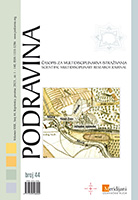- NIKOLA VII. ZRINSKI U AUTOGRAFU »PUTOPISA« EVLIJE ČELEBIJA
- PONOVNO PROMIŠLJANJE OBRANE NOVOG ZRINA
- RAKIČAN MANOR AS A MONUMENT OF PROMINENCE IN TIME AND SPACE
- EKONOMSKA STABILIZACIJA KAO ZAKLJUČAK JUGOSLAVENSKOG SOCIJALISTIČKOG PROJEKTA U STUDIJAMA SLUČAJA: INDUSTROGRADNJA I GK MEĐIMURJE 1980. – 1985.
- UPRAVLJANJE I RAZVOJ KARIJERA RADNO AKTIVNOG STANOVNIŠTVA GRADA KOPRIVNICE
- UTJECAJ PROMETNE DOSTUPNOSTI NA PROMJENU BROJA STANOVNIKA I STARENJE STANOVNIŠTVA U KOPRIVNIČKOKRIŽEVAČKOJ ŽUPANIJI OD 1961. DO 2021.
- THE EDUCATIONAL SITUATION OF THE DRÁVA REGION IN THE LIGHT OF DAILY PHYSICAL EDUCATION
- SJEĆANJE - ŠTO SAM RADILA KAO POVJESNIČARKA OD OSAMDESETE DO DEVEDESETE GODINE ŽIVOTA (2013. – 2023.)
- BIBLIOGRAFIJA MIRE KOLAR-DIMITRIJEVIĆ (2012. – 2023.) U POVODU 90 GODINA ŽIVOTA
- IN MEMORIAM MIJO LONČARIĆ (1941. – 2023.)
- PRIKAZI NOVIH KNJIGA, ČASOPISA I ZNANSTVENIH SKUPOVA
RAKIČAN MANOR AS A MONUMENT OF PROMINENCE IN TIME AND SPACE
The article covers the Rakičan Manor in space and time. Rakičan is located 1 km east of the town and municipality of the same name, Murska Sobota, the capital of Prekmurje. A region that is still associated with agriculture and fertility. Prekmurje was under the dominion of the Hungarians for more than 800 years. The conquered territory of Prekmurje was integrated into the Kingdom of Hungary around 1100 and formally remained part of the country until 1919 when the Treaty of Trianon was signed. Rakičan Manor is located on the outskirts of an 11-hectare English park. The park underwent its initial landscaping in the 17th century, and by the 18th century, its layout had conformed to the prevailing stylistic preferences of Hungarian feudal lords during that eraThe park featured the cultivation of numerous fruit trees native to Hungary, alongside non-indigenous species of fruit and ornamental trees, predominantly sourced from Italy. The present-day shape of the surroundings of the manor has been preserved since at least the 1880s. Due to the lack of historical sources, the remoteness, and the rural character of the building, much of the history of Rakičan is unknown, However, it exhibits some Baroque elements, especially on the façade, typical of rural manor structures that can be compared with similar buildings in neighboring countries. Once a strategic fortress of defence against the Turkish invasions, the manor underwent a transformation in the 17th century under Counts Ádám I and Ádám II Batthyány to become a summer country residence with a Baroque touch. This change was mainly influenced by the progressive extension of Baroque forms from Vienna and Graz to the territory of Hungary and Prekmurje by the Hungarian counts. With its new Baroque appearance, the manor house, as the seat of the then recently autonomous Rakičan estate, became a commodious summer residence comparable to the more impressive estates in Hungary. The subject is approached and analyzed from a historically critical point of view, and therefore a multi-method approach is implemented.
Stručni rad / Professional paperAndreja BENKO

